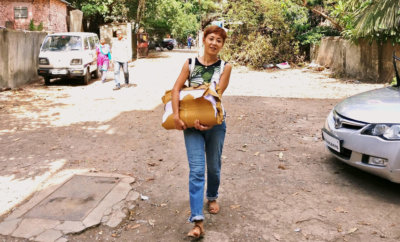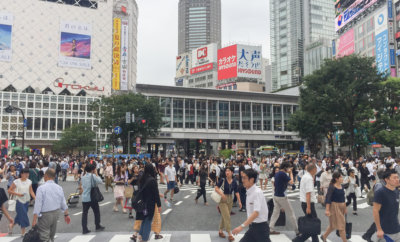Arts
Expat Voice: Manga And More
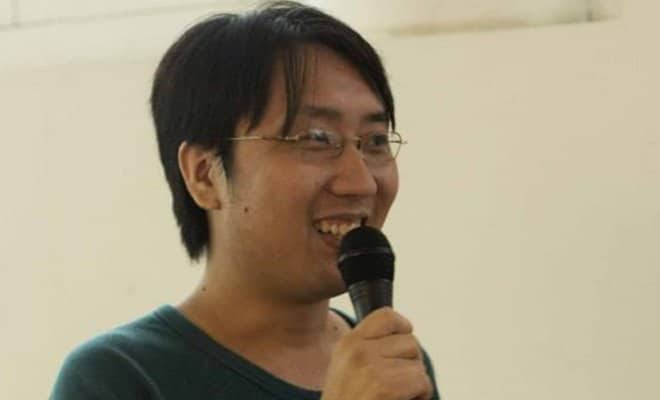
Shohei Emura
Facebook/Captain Bijli Comics
Shohei Emura's life in India revolves around art, whether it is promoting Japanese manga culture, telling Indian stories in comic books, or strengthening a community of artists.
Japanese comic artist Shohei Emura came as a tourist to India 17 years ago, when he was seeking change. Emura, then aged 22, was soon convinced that India was a good place to fill the cultural gaps in his life.
“I learnt in India that there are many lifestyles of people, who come from different backgrounds, within the same society,” Emura, 39, who hails from Hitoyoshi, Kumamoto Prefecture, tells Little India. “That always excites me and keeps me aware of new things in daily life.”
He enrolled in Maharaja Sayajirao University of Baroda in 2001 to pursue a Bachelor’s in Fine Arts. After graduating in 2005 he traveled around the country for two years, finally deciding to live in Delhi for comic book publishing.
The sheer size of India makes it a country that’s nothing like Japan, says Emura, who has been involved in promoting the Japanese manga art, exploring Indian forms of story-telling, and strengthening a community of artists in the country. He tells us more about keeping his passion alive in India:
Manga in India
I often used manga-based techniques for left to right horizontal panel placement, which is how English and some other languages are read. It’s because my comic script is set in English by the script writer or myself when I’m writing for Indian and international audience. I recently started using digital drawing mixed with texture painting and classic analog drawing for manga drawing.
Traditional Indian Story-telling Formats
I worked with Vidyun Sabhaney on a story Chilka, which is a part of PAO anthology Volume-1, which was published in 2012. We planned to travel and research on story telling forms with visual elements in India to learn more about the authentic way of story-telling. We thought that will help us compose Indian-style manga hybrid comics later.
I was excited to see how myth and folktales are told and depicted. This turned into a little larger project with the help of the India Foundation of Arts NGO and some private supporters.
We spent a year traveling in Rajasthan, West Bengal and Karnataka for research on three different traditions — Kaavad, Bengali pattachitra and Karnataka shadow puppetry. We did follow-up trips and research for a few more years while publishing comics from our self-publishing brand, Captain Bijli Comics.
Comic Culture
We published a small zine called Mice Will Be Mice, which was based on the script of shadow puppetry that we created for a children’s workshop at Nizamuddin Basti in New Delhi. Then we started more comics related activities. We collaborated with an indie publishing NGO called Authors Upfront, and American comics researcher Jaromir Stoll and Sabhaney, who edited the DOGS! anthology. It’s a comic book anthology on dogs theme. I wrote Oye! Chhotu, a story of stray dogs in Mehrauli forest.
I have made wall-printed comics for Japanese restaurants Kofuku and Kanpai in Mumbai. I also hold manga workshops and have been a guest lecturer at various institutes.
I made programs which are specific to manga publishing, based on the method of how I made manga-based comics in English. This kind of information is a little rare in books, and even on the internet right now.
My aim is to help more amateur comic book artists, and organize a bigger movement of zine culture and major mass comics publishing. The market in India is still tiny as compared to the population, and I expect it to expand in the near future.
Barter Art
I didn’t have much cash during the demonetization phase. I made paintings of the things I needed, such as medicines, food items and everyday products, titled the painting about what I wanted, such as “Olive oil,” and exchange it for real olive oil. I exchanged about 15 paintings in two runs of this event. It was very interactive and fun. I want to continue and develop this activity.
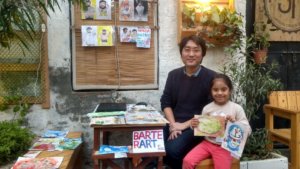
Shohei Emura during a Barter Art session
I also sold and accepted barter portrait made in different manga styles. It picked up initially, but most of the orders got cancelled as demonetization happened.
Working for Indian Children
I made mural paintings at classrooms in government school in Dilshad Garden in New Delhi, using educational and informative design.
I think there is a big demand for children to be able to stay in better educational environments, besides their studies, such as clean air, water and toilet facilities. Proper care needs to be taken for their school life in India. I would like to create valuable content for them.
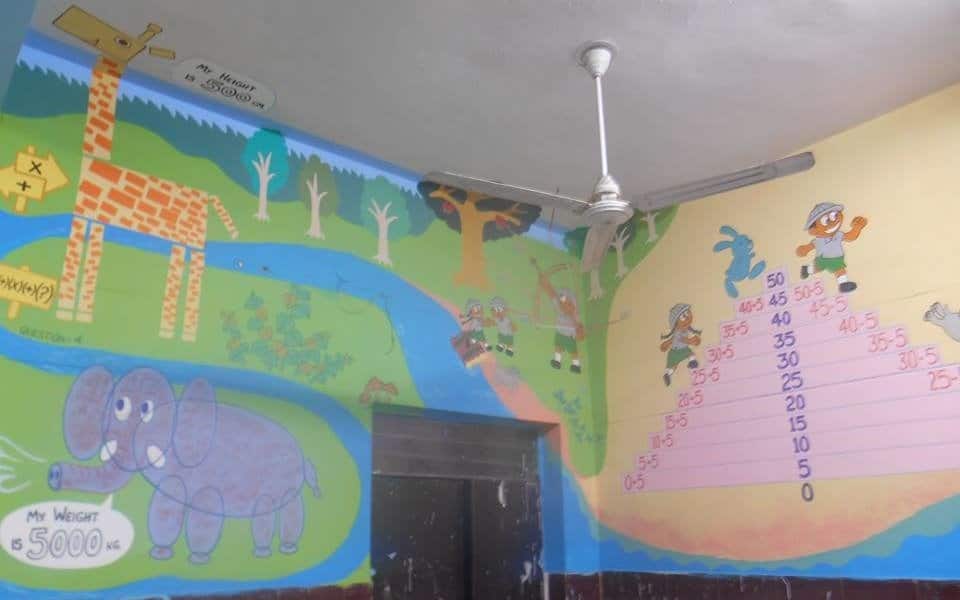
Shohei Emura’s murals at a government school in Dilshad Garden, New Delhi
Future Plans
My next ideas are an experimental ecology game comic for social networking sites and reintroduction of folktale web-comic series. I am moving to online comic format for better stability, as I’m not sure whether I will be staying in India or Japan, and for reaching new audience across the world. I may take to blogging or YouTube, or gather funds from crowd sourcing.
The Traveler Within
I like many places in India. Delhi is great to see the change of society and urban life in India. Kolkata would be a good place to work as well if I was not into publishing. Baroda is my second home.
Stability Concerns
There are always issue with the visa extension and I am currently in Japan for my next application. It is not very easy to plan for a long stay in India. My parents are often worried about that stability, even though they did not object to me moving abroad as many from my family have pursued this path. However, I still have to convince them about my future plans. It has been harder and harder after big incidents like riots, demonetization, etc.
The interview has been condensed and edited.
Expat Voice is regular column on expats in India. Email us at expat@littleindia.com to nominate yourself or another expat for the column.


